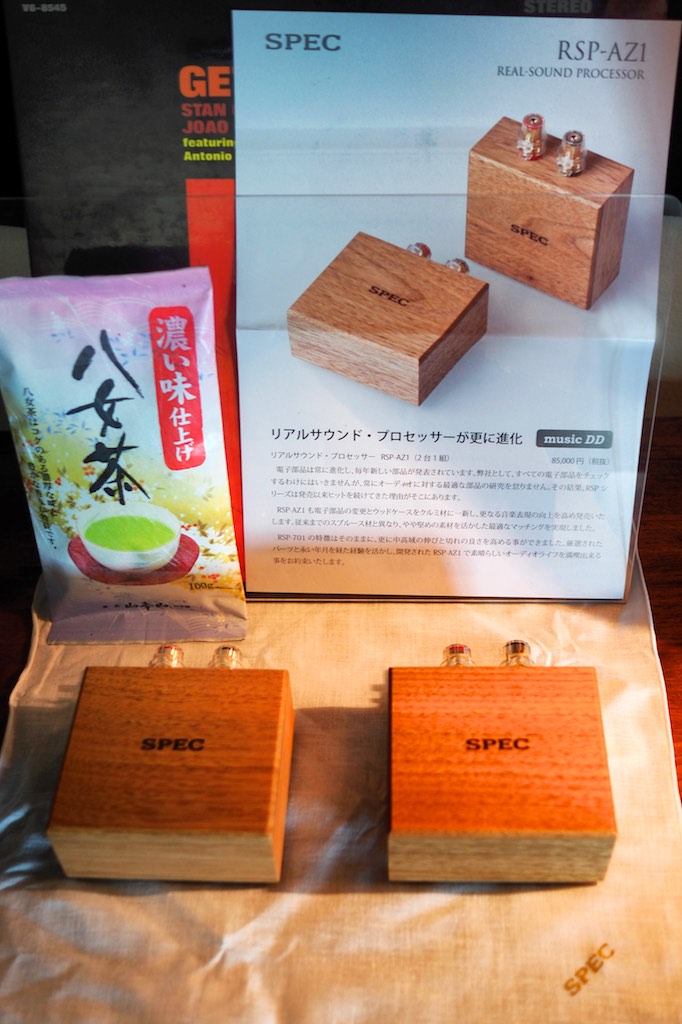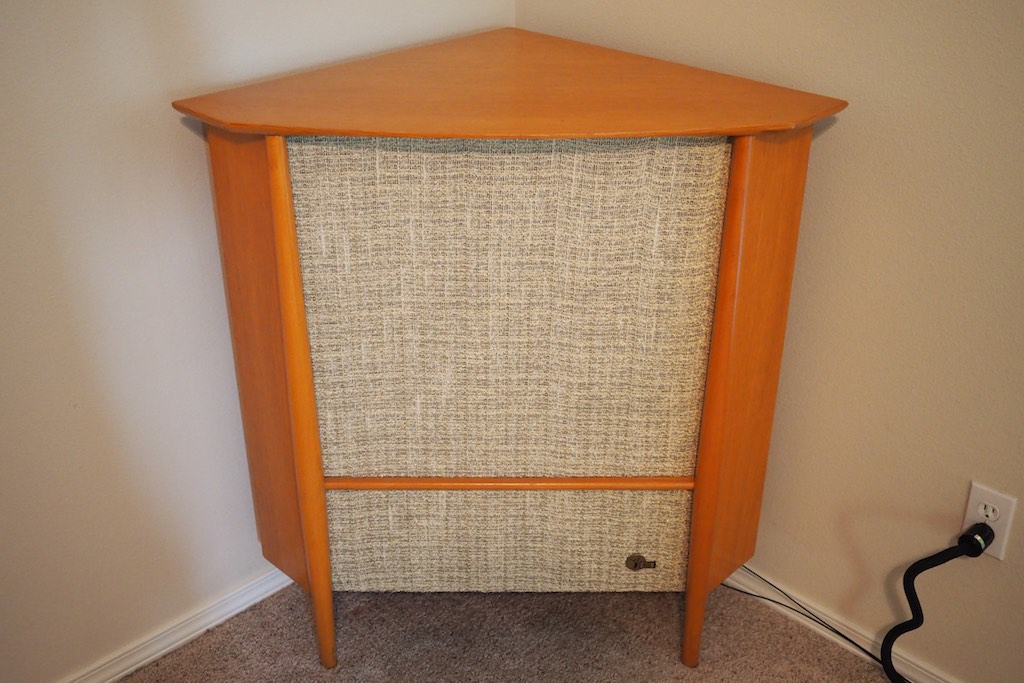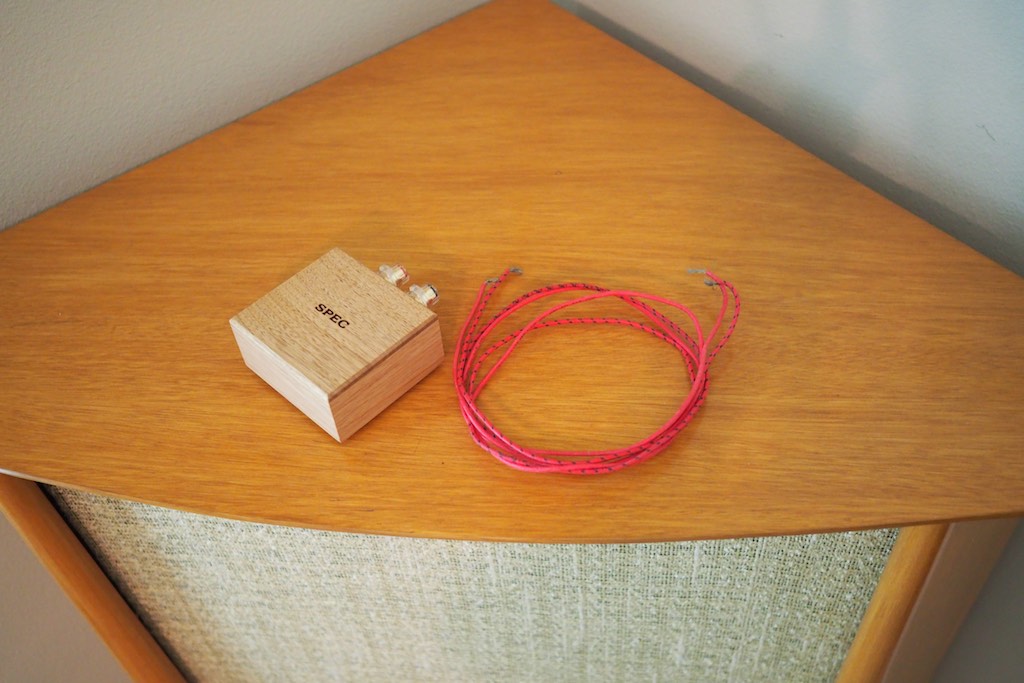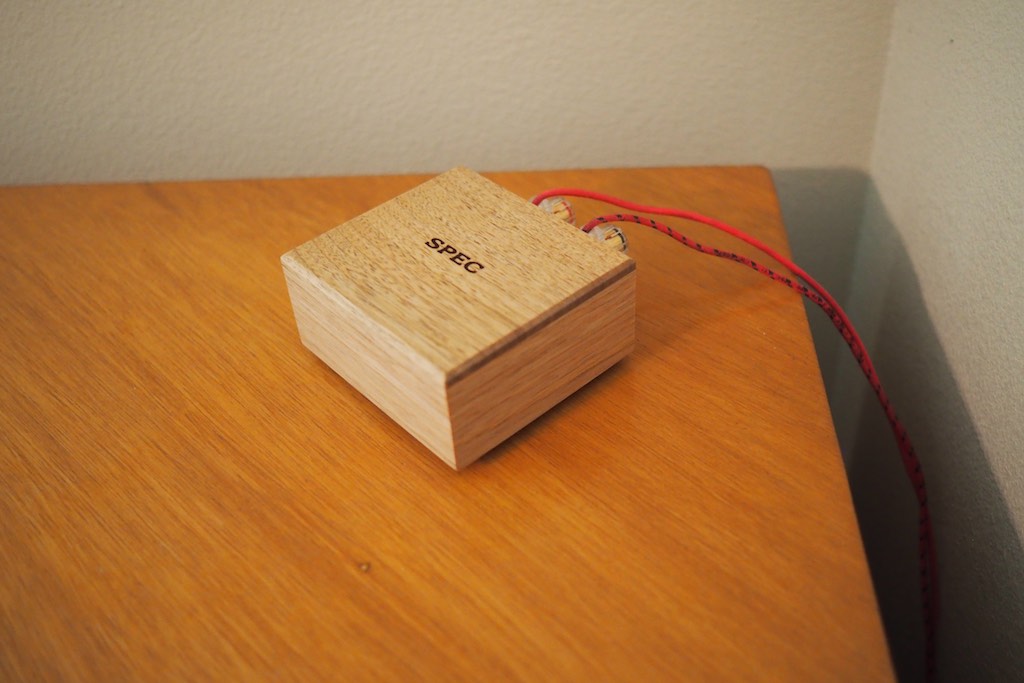I think most of you know I've been having a "love at first listen" affair with my vintage Altec Corona 832A loudspeakers that I purchased from LA Jazz Audio.
It is a little hard to tell in the accompanying photographs, but the Altec Corona 832A's are fairly large loudspeakers, being about as wide as my Tannoy Westminster Royal SE loudspeakers, but only about 2/3 the height.
The cabinets were custom made for Altec by Glenn of California, which was a craft furniture maker producing furniture in the California Modernist style that was popular in the 1940s-1950s, and the cabinets were designed to tuck into room corners and match your other furniture from Glenn of California.
My Corona's have a components compliment of 803A bass drivers (1947-1958), 802D compression drivers (1957-1972), 811B HF horns, and N800E crossovers, which would put their production circa 1957-1958.
Even though my Corona's are about the same age as I am (sixty years old), they are in remarkably good shape (unlike me), and didn't need any attention to put them in playable condition.
The Corona's sounded pretty good in my living room system where the Westminster's normally sit, but I've really been enjoying them in my bedroom system, tucked away into the room corners.
My smallish nuevo-bungalow home is laid out a bit unconventionally in that the master bedroom is nearly the size of my living room, while the rest of the rooms are of modest size.
With the Corona's in the room corners there's actually quite a lot of living space left in the room, and more importantly, they sound superbly musical - I love them!
To get my Corona's up and running as a bedroom system, I kicked things off with my single-ended-pentode Almarro EL84 integrated amplifier for amplification, which can easily power the Corona's to live-like volumes with its 5 watts of pentode power. The Almarro is connected to the Corona's with Duelund DCA16GA as speaker cables.
I've been using my iMac as a source, and playing music through an Mhdt Paradisea USB DAC, with a Sablon Audio Gran Corona power cord, and Duelund DCA16GA interconnects.
The result was remarkably satisfying, and I've enjoyed many a late-night listening session with that combination.
Then the Still Audio EL84 integrated amplifier arrived, and with Mark Still's encouragement I placed it in with my Corona's to get some run-in time.
While the Almarro had really nice mid's and high's on the Corona's, I realized after putting the Still Audio EL84 amplifier into the system that the Corona's were capable of some really quality bass performance as well.
The Still Audio EL84 is probably only a third or so of the way through a proper run-in of a hundred hours, but it's already sounding really satisfying musically & sonically, and I'll have some more detailed "first impressions" notes to share with you about the Still Audio EL84 amplifier in the near future.

Care package from Yazaki-san! Some excellent Japanese green tea to relax with while listening to music, and custom RSP-AZ9EX's for the Corona's!
Now onto the subject of this post, the custom pair of Spec RSP-AZ9EX Real Sound Processors (impedance compensators) that Yazaki-san made specially for my vintage Altec Corona 832A loudspeakers.
Incidentally, Yazaki-san shared with me that this will be his final project with Spec before his retirement. As a new retiree myself, I want to wish Yazaki-san a happy retirement and welcome him to the club! If my retirement experience is any kind of a predictor, you've got lots of good things to look forward to Yazaki-san!
Let me share with you some lightly edited excerpts of what Yazaki-san told me about the function of the Real Sound Processors:
"The operating principle of our “Real-Sound Processor” was made public in the Japanese specialty magazine MJ “Audio Technology” by Mr. Akira Yasui in 1971, where he described his concept for an “Impedance Compensator“.
Yasui-san was a senior amateur researcher and a person of authority of semiconductor linear amplifiers, and we can still see his articles in recent issues of MJ!
Yasui-san came to the conclusion that improving only the static characteristics of the semiconductor power amplifier would never bring the superior quality sound he sought, and he described the importance of an amplifier's dynamic characteristics, including the actual movement of the speaker, to get superior musical sound.
Even after more than 40 years have passed, I still regard his view point as an excellent insight and a relevant challenge for present day audio technology.
So needless to say, I recognize that improving the dynamic characteristics of the system, consisting of amplifier and speaker, might be an extremely important factor in getting superior sound quality.
Even with all the advances since then, we have not attained an effective measurement method for dynamic amplifier and loudspeaker behaviors that correlates well with our hearing. I suppose that so many reasons might exist, but one of the major difficulties of analysis of the dynamic characteristics are the characteristics of the speaker itself.
Needless to say, the speaker is the transducer which converts some electrical energy to kinetic motion. I would say frankly, this transducer, influenced by inductance, capacitance, and resistance factors would be a collectively imperfect and have complicated characteristics for being driven by an amplifier, given how fluctuant the impedance frequency characteristics are, you know.
Yes, it must be quite simply a hard and tough load of an amplifier to follow, but let me remind you of one more thing, the “counter-electromotive force” of the speaker.
The motion of speaker is started in the magnetic circuit (or voice-coil of the unit) by the current flowing from the amplifier, which according to Fleming's left-hand rule means at the same time this motion raises up counter-electromotive force in the voice-coil by Fleming's right-hand rule.
It is true that the amplifier drives the speaker, but the fact is that the speaker affects the amplifier by this counter-electromotive force, and this counter-electromotive current returns to the amp via the speaker cable, making it more difficult to drive the speaker in accordance with the input signal.
This current causes a negative effect especially on the traditional semiconductor linear amplifier, as well as tube amplifiers with negative feedback circuitry. Particularly, the transfer function of semiconductor is poor in linearity compared to the characteristic of tube, so this type of amplifier inevitably needs to correct the static characteristic by performing deep negative feedback. But this negative feedback makes the amplifier stage vulnerable to the counteraction, counter-electromotive current from speaker, causing complicated phase delays inside of the amplifying stage. Needless to say, this physical phenomenon hurts the sound quality of the audio system, including amplifier and speaker.
This is what our Real Sound Processor is designed to address, and it has two major functions, one is making an improvement to reduce the fluctuations of a speaker’s impedance frequency characteristic, and the other is absorbing that counter-electromotive current from the speaker, including a network composed of some inductors.
Accordingly, the processor makes it possible for the amplifier to drive the speaker more faithfully to the sound source, improving the sound resolution and the dynamics, also reproducing more natural resonances.
Above all it helps you find a deep, rich, 3D-like sound stage full of fascinating tonal characteristics that you have never experienced before, and it allows your amplifier to drive the speaker easily!
In a word, with this impedance compensator, we can get coherent sound throughout the entire range, and also it would be a necessary condition for achieving “Real-Sound”, I believe."
I've used the original Spec RSP-901EX Real Sound Processors Yazaki-san sent me to try with excellent effect on my Harbeth Super HL5 loudspeakers, and it was an across the board improvement in musicality and sonics that I really enjoyed.
Those original Spec RSP-901EX Real Sound Processors didn't work as successfully with my Tannoy Westminster Royal SE loudspeakers, and while they were impressive in some ways, I ended up taking them out of the system because I thought they made the upper midrange and high frequencies too forward and assertive.
I should also mention that the original Spec RSP-901EX Real Sound Processors are optimized for loudspeakers of 10 Ohms or less, so they really weren't intended for vintage loudspeakers like my 16 Ohm Altec's, thus the custom pair of Spec RSP-AZ9EX Real Sound Processors that Yazaki-san built to complement the vintage 16 Ohm Altec 832A Corona loudspeakers.
Like all Spec products, the RSP-AZ9EX Real Sound Processors are beautifully made, housed in a walnut chassis, with what looks like the same binding posts as used on Spec amplifiers.
I haven't asked Yazaki-san about the internal circuit specifics of the RSP-AZ9EX's yet. I assume the "AZ" signifies the use of Arizona Capacitors, but I don't yet know what the identity of complementary resistors or inductors that comprise the impedance compensation circuit.
Anyways, to connect the RSP-AZ9EX Real Sound Processors to my vintage 16 Ohm Altec Corona loudspeakers, I used well run-in lengths of Western Electric WE16GA tinned-copper wire, just like I imagined Yazaki-san would do!
At first listen upon hooking them up, I thought the Spec RSP-AZ9EX Real Sound Processors might end up being too forward and assertive in the high-frequencies, like the RSP-901EX's were with my Westminster's, but I left them in place so I could run-in their circuit components for a while before coming to any conclusions.
After a couple of days of run-in time the Spec RSP-AZ9EX Real Sound Processors were transformed, smoothing out, losing the initial forwardness I heard, and basically sounding really nice and complimenting the system's performance both musically and sonically.
So my first impressions are that as the Spec RSP-AZ9EX Real Sound Processors have started to run-in, the result has been an increase in the gorgeous tone my Corona's are capable of, more musical nuance, more naturally presented timbral textures, more nuanced dynamics across the range, and an increased sense of presence of the images.
In essence, the Spec RSP-AZ9EX Real Sound Processors positively dealt with some of those little red flags that signal one is listening to recorded music instead of "real" music, with the net effect of making the music flowing out of the Corona's sound more live-like.
As with all my "first impression" reports, these are brief impressions of a snippet in listening time rather than the last word on their performance, so stay tuned as I learn more about them over time, and share that with you in future posts.
I'll be listening to them until I'm sure the Spec RSP-AZ9EX Real Sound Processors have had time to fully run-in, and that I've figured out how to fully optimize them in my vintage Altec Corona 832A loudspeaker system.
Even though the custom Spec RSP-AZ9EX Real Sound Processors are sounding great right now and you can consider me impressed, I suspect that they will continue to evolve musically & sonically with more time on them, so I'll be reporting back after I'm sure they've fully run-in and I'm getting the best from them.
I also want try the custom Spec RSP-AZ9EX Real Sound Processors with a few different amplifiers powering the Corona's in order to hear how amplifier performance is affected by them. I'm thinking the Almarro A205A, Still Audio EL84, and the Spec RSA-M3 EX Real Sound Amplifier are all excellent candidates.
Also, please allow me to say "Thank you, Yazaki-san!" for building this custom set of Spec RSP-AZ9EX Real Sound Processors to try with my vintage Altec 832A loudspeakers, I truly appreciate your thoughtfulness and insights!
As always, thanks for stopping by, and may the tone be with you!





































